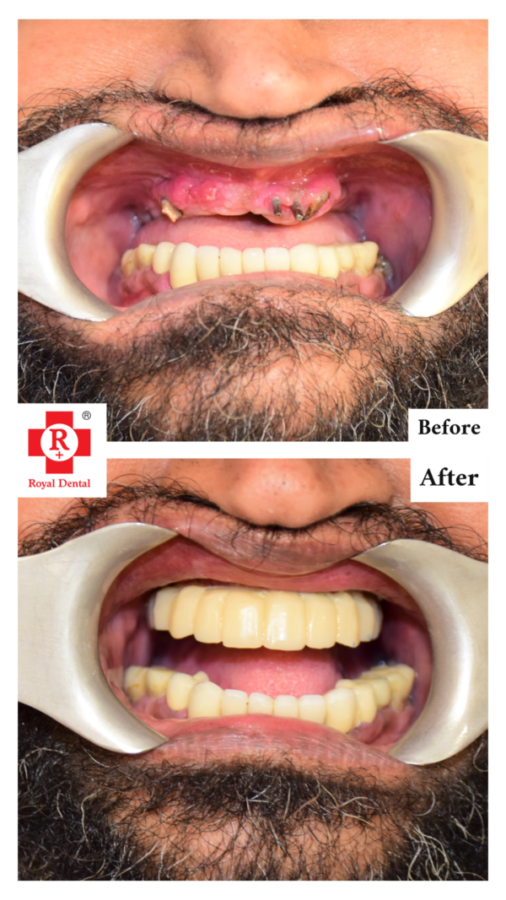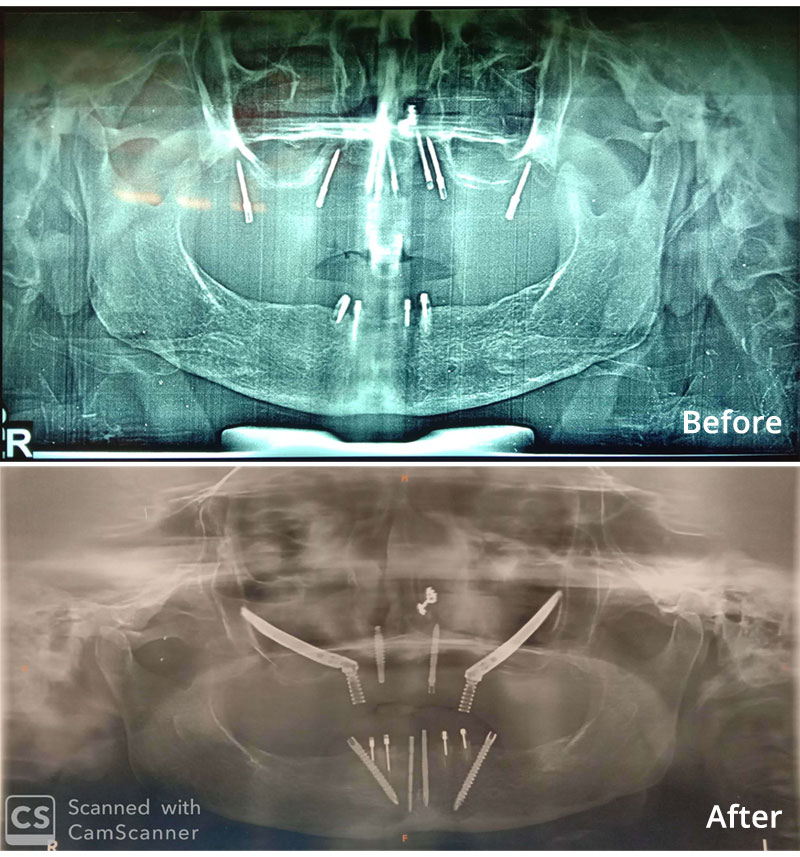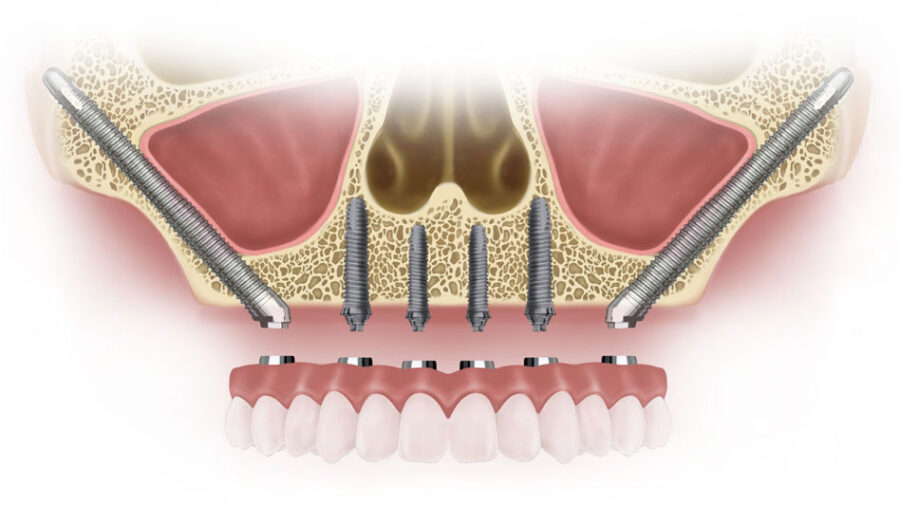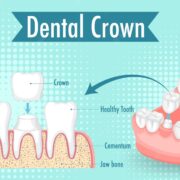Zygomatic dental implants are one method that stands out as a ray of hope for people having difficulties with traditional implantology in the field of dental innovations, where technology meets creativity. In a perfect world, your smile would serve as both a monument to the wonders of contemporary dentistry and a reflection of your pleasure. We explore the function and design of zygomatic implants in this blog, revealing the mysteries of this revolutionary dental treatment.
Purpose of Zygomatic Dental Implants
Zygomatic implants are intended to address a particular set of issues related to upper jaw tooth loss. When people lose teeth in the upper arch, the traditional method of placing ordinary dental implants may not work well since there is not enough bone mass.
The maxilla, or upper jaw, frequently has a lower bone density, which makes it difficult to successfully place conventional implants. The goal of zygomatic implants in these situations is to give people who would otherwise have few alternatives for tooth replacement a workable and creative solution.



The zygomatic bone, a strong, thick bone found in the cheek region, is where these implants get their name. Zygomatic implants are positioned carefully in the zygomatic bone, as opposed to standard implants that attach to the jawbone, to get around the problems caused by inadequate bone in the upper arch.
The insertion of prosthetic teeth is made possible by the zygomatic bone, which provides the implants with a strong and sturdy support system. Even in cases where traditional implants may not be practical, dental experts can provide patients with a functional and aesthetically acceptable option by using the zygomatic bone as an anchoring point.
Diagnostics Setup of Zygomatic Implants
Mirror: The purpose of a dental mirror is to provide dentists with a reflecting surface that helps them see places inside the mouth cavity that are difficult to see otherwise. It is useful for inspecting the gums, teeth, and other oral tissues.
Probe: Dental probes are thin, pointed tools used to gauge the depth of pockets surrounding teeth. They support the assessment of gum health and the detection of possible problems, like periodontal disease.
Tweezers: They are precise tools used in dental settings to handle and manipulate tiny things. They might be used to place materials, cotton rolls, or other equipment during the diagnostic phase.
Excavator Spoon: The spoon excavator is a dental tool used in tooth preparation that is intended to remove carious dentin. Before receiving an implant, it helps to clean and shape the tooth.
Kidney Tray: The kidney tray serves as a shallow, kidney-shaped receptacle for holding and organising diagnostic tools during exams. It guarantees the dentist will have a tidy and orderly workstation.
Gauze: The purpose of gauze is to keep the area dry during diagnostic procedures. It is meant to absorb blood and saliva so that the dentist can see more clearly.
Cotton Holder: The cotton holder’s function is to retain and secure cotton rolls. During diagnostic procedures, these rollers are used to isolate and dry particular parts of the mouth cavity.
Waste Receiver: The waste receiver’s purpose is to securely dispose of spent materials like cotton, gauze, and other disposable products. It is usually in the form of a container or bin. It aids in keeping the dental office hygienic and tidy.
Surgical Setup of Zygomatic Implants
No. 15 blade
Blade No. 15 is a medical scalpel blade designed to cut with a tiny, curved edge. It is frequently employed to make soft tissue incisions that allow access to the underlying structures.
Bone burs
Bone burs are cutting instruments used to work with and alter bone. They are essential in dental implant surgery because they provide the exact shape and depth needed for the best possible stability of the implant while also preparing the bone site for implant insertion.

Tweezers
Tweezers are employed during the surgical phase to handle small items and materials, much like they are during the diagnostic step. They help to maintain a sterile environment and are involved in the accurate positioning of components.
Moon’s Probe
Moon’s probe is a specialist tool used to identify and investigate soft tissues and bone, among other anatomical features. It helps the dentist measure the surgical site and make sure everything is precise when doing the operation.
Bone Files and Periosteal Elevator
The purpose of bone files is to smooth and shape bone surfaces so that implants fit properly. To improve access and vision during surgery, periosteal elevators are used to raise the periosteum, the layer of tissue that covers the bone.
Forceps and scissors
The purpose of surgical scissors and forceps is to cut and manipulate delicate tissues. By eliminating extra tissue and preserving a clean field of vision, they aid in the management of the surgical site.
Suture needle
During the implantation process, incisions are stitched and closed using suture needles. They enable accurate and safe wound closure since they are available in a variety of sizes and forms.
Suture Thread
The purpose of suture thread, also called surgical thread, is to seal incisions by using it in conjunction with a suture needle. It offers the power and stability required for the wound to heal effectively.
Retractors
Retractors serve the purpose of holding back organs and tissues so that the surgical site may be seen clearly. They help expose the jawbone and adjacent bones during dental implant surgery so that the implants may be positioned.
Actual Implant Placement Setup
- Lignocaine 2% injection: local anesthetic for pain control.
- Lignocaine spray: topical anesthetic for numbing the mucous membrane.
- Syringe: Administers local anesthetics.
- Scale: measures and mixes medications.
- Glass bowl: container for mixing solutions.
- Implant Handpiece: Instrument for drilling and placing the implant.
- Implant Drills: Various drills are used to prepare the bone for implant placement.
- Implant hand key: used to manually place and secure the implant.
- Tetanus injection vial: administered after the implant is placed.
- Normal saline is used for irrigation and cleaning.
- 2 ml, 5 ml syringe: administers fluids and medications.
Composite Setup (After the Implant is placed)
After a dental implant is placed, a composite setup is created using a number of tools and supplies intended for the restorative stage of the process. The goal of this phase is to restore the patient’s teeth’s appearance and functionality. Each part of the composite setup is explained as follows:
Etch: The purpose of etching is to apply an acidic gel on the surface of teeth. Its goal is to improve the binding between the composite material and the tooth by introducing micropores into the enamel. As a result, the repair will adhere better and last longer.
Bond: The purpose of bond is to apply an adhesive substance following etching. It creates a solid connection between the composite material and the tooth structure. By ensuring a strong and long-lasting bond, this bonding agent extends the life of the dental repair.
Q Tip: The purpose of the Q tip, also known as the cotton swab, is to apply compounds like etch and bond precisely. It enables the dentist to administer these materials in a controlled way, guaranteeing uniform coverage and the best possible bonding.
Composite Flowable: The goal of composite flowable is to create a fluid composite resin. Its function is to close up minor or complex gaps in the tooth’s structure. This material is especially helpful in places where typical, more viscous composites are difficult to access.
Continuing Composite Setup Steps (After the Implant is placed)
Composite Packable: The purpose of composite packable is to make composite resin denser. When additional material is needed for larger restorations, it is utilized. With this kind of composite, the tooth may be shaped and constructed to resemble its natural shape.
Light: The light is used to polymerize or harden the composite material; it is frequently a high-intensity curing light. The composite hardens and bonds to the tooth structure because the light triggers a photo-initiator in the material. This stage guarantees a solid and long-lasting repair.
Eye Shield: The purpose of an eye shield is to protect the patient and the dentist from light rays throughout the treatment. It protects the eyes from the strong light that the healing light emits, avoiding any possible eye damage.
Composite Instruments: The purpose of composite instruments is to shape and sculpt composite material using a collection of tools. They help create a smooth and visually beautiful restoration by shaping it to resemble the tooth’s original structure.
Conclusion
For people with particular dental issues, Zygomatic Implants become a ray of hope in the quest for a brilliant smile. One smile at a time, Dr. Chirag Chamria’s dedication to excellence at Royal Dental Clinics exemplifies the artful and scientific fusion in perfect harmony. As you set out on your path to a restored smile, keep in mind that your dental health is a blank canvas just like you are, and Zygomatic Implants are here to help you create a masterpiece.






